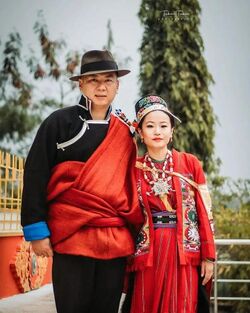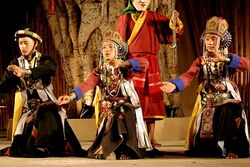History:Monpa people
 A Monpa man and woman in traditional attire | |
| Total population | |
|---|---|
| 75,000[citation needed] | |
| Regions with significant populations | |
| 60,545 (2011 census)[1] | |
| 10,561 (2010 census)[2] | |
| 3,000[citation needed] | |
| Languages | |
| East Bodish languages, Tshangla language, Kho-Bwa languages | |
| Religion | |
| Tibetan Buddhism | |
| Related ethnic groups | |
| Sherdukpen, Sharchops, Memba, Limbu | |
The Monpa[lower-alpha 1] (Tibetan: མོན་པ་, Wylie: mon pa, THL: mön pa) is a major tribe of Arunachal Pradesh in northeastern India . The Tawang Monpas have a migration history from Changrelung. The Monpa are believed to be the only nomadic tribe in Northeast India – they are totally dependent on animals like sheep, cow, yak, goats and horses. The Monpa have a very close affinity with the Sharchops of Bhutan.
Name
Tibetan Buddhists texts present "Monyul" (literally, "low land") as the territory immediately to the south of Tibet below the Himalayan crest line. Its borders were imprecise, but roughly stretched from eastern Bhutan and western Sikkim to the Tawang area. "Monpa" were the people of Mon and they were distinguished from "Lopa" (also spelt "Lhopa"), who were the wild and intractable tribes of the Assam Himalayan region. In practice, Monpa were people amenable to the proselytising efforts of the Buddhist monks, whereas Lopa wer those inimical to them.[3]
In course of time, the various people of the historical "Monyul" came to be called by other names, such as Lepcha for the tribes of Sikkim and Drukpa for the people of Bhutan, but the people of Tawang continued to own the name "Monpa".[4]
Distribution
Most Monpas live in the India n state of Arunachal Pradesh, with a population of around 60,000, centered in the districts of Tawang and West Kameng. About 20,000 live in the Tawang district, where they constitute about 97% of the district's population, and almost all of the remainder can be found in West Kameng district, where they form about 77% of the district's population. A small number live in East Kameng district.Cite error: Closing </ref> missing for <ref> tag
The Monpa are sub-divided into six sub-groups because of variations in their language. They are namely:[citation needed]
- Tawang Monpa
- Dirang Monpa
- Lish Monpa
- Bhut Monpa
- Kalaktang Monpa
- Panchen Monpa
History
A state of Lhomon or Monyul is believed to have existed from 500 B.C to 600 A.D. centered in the present day Bhutan.[5][better source needed] In the 11th century, the Northern Monpas in Tawang came under the influence of the Tibetan Buddhism of the Nyingma and Kagyu denominations. At this time the Monpa adopted the Tibetan alphabet for their language mainly for religious purposes. Drukpa missionaries came to the region in the 13th century, and missionaries of the Gelug school came in the 17th century. The Gelug school is the sect to which most Monpas belong today.Cite error: Closing </ref> missing for <ref> tag[better source needed]
Monyul remained an autonomous entity, with local monks based in Tawang holding great political power within the kingdom, and direct rule over the area from Lhasa was established only in the 17th century. From this time until the early 20th century, Monyul was ruled by authorities in Lhasa.[citation needed] One of the first British-Indian travellers into Monyul, Nain Singh Rawat, who visited the area from 1875 to 1876, noted that the Monpa were a conservative people who shunned contact with the outside world and made efforts to monopolise trade with Tibet.[citation needed] In 1914, as part of the negotiations for the Simla Convention, Britain and Tibet negotiated their mutual border roughly along the crest of the Himalayas, which came to be called the McMahon Line. The line divided the land in which the Monpas inhabited, and became a source of contention in subsequent years because of ambiguities in the specific location of the McMahon Line.[citation needed]
Languages
The languages spoken by the Monpa people are often referred to as the "Monpa languages". This is not a genealogical term, and several quite different languages are subsumed under it. "Monpa languages" include Kho-Bwa, East Bodish, and Tshangla languages. According to Blench (2014), five groups may be distinguished:[6]
- The Sherdukpen, Lish, and Sartang languages show no obvious relationship to other languages of the region and they comprise a small language isolate cluster. These three languages are related to Bugun, and form a "Kho-Bwa" group together with it.
- The Tawang language is an East Bodish language, and is a variety of Dakpa.
- The languages of the Zemithang, Mago and Thingbu villages are additional East Bodish varieties that are not mutually intelligible with Tawang.
- The Tshangla language within Bodish comprises closely related dialects spoken in the villages of Nyukmadung and Lubrang and the Brokpa language spoken by nomads. Other languages include Dirang (also known as "Central Monpa"), Murshing and Kalaktang (also known as "Southern Monpa").
Culture
The Monpa are known for wood carving, painting, carpet making and weaving. They manufacture paper from the pulp of the local sukso tree. A printing press can be found in the Tawang Monastery, where many religious texts are printed on local paper and wooden blocks, usually meant for literate Monpa Lamas. They are also known for their wooden bowls and bamboo weaving.[7]
All animals except men and tigers are allowed to be hunted. According to tradition, only one individual is allowed to hunt the tiger on an auspicious day, upon the initiation period of the shamans, which can be likened to a trial of passage. After the tiger is killed, the jawbone, along with all its teeth, is used as a magic weapon. It is believed that its power will enable tigers to evoke the power of the guiding spirit of the ancestral tiger, who will accompany and protect the boy along his way.
Religion
The Monpa are generally adherents of the Gelug sect of Tibetan Buddhism, which they adopted in the 17th century as a result of the influence of the Bhutanese-educated Merag Lama. The testimony to this impact was the central role of the Tawang Monastery in the daily lives of the Monpa folk. In Zemithang the Monpa are adherents of the Nyingmapa strand of Mahayana/Tantrayana-tradition.[8]
Festivals
Principal Monpa festivals include the Choskar harvest festival, Losar, and Torgya. During Losar, people generally offer prayers at the Tawang Monastery to pray for the coming of the Tibetan New Year. Pantomime dances are the principal feature of the Ajilamu festival.
Buddhist lamas read religious scriptures in the gompas for a few days during Choskar. Thereafter, the villagers walk around the cultivated fields with sutras on their back. The significance of this festival is to pray for better cultivation and the prosperity of the villagers, and protect the grains from insects and wild animals.
Society
The traditional society of the Monpa was administered by a council of six ministers locally known as Trukdri. The members of this council are known as Kenpo, literally the “Abbot”. The Lamas also hold honored positions, two monks known as Nyetsangs, and two other Dzongpen.
The man is the head of the family and he is the one who makes all decisions. In his absence, his wife takes over all responsibilities. When a child is born, they have no strict preference for a boy or a girl.
Lifestyle and dress
The traditional dress of the Monpa is based on the Tibetan chuba. Both men and women wear headwear made of yak hair, with long tassels. The women tend to wear a warm jacket and a sleeveless chemise that reaches down to the calves, tying the chemise round the waist with a long and narrow piece of cloth. Ornaments are made of silver, corals and turquoise. Sometimes a person wears a cap with a single peacock feather in a felt hats.
Due to the temperate climate of the eastern Himalayas, the Monpa, like most of the other ethnic groups in the region, construct their houses of stone and wood with plank floors, often accompanied with beautifully carved doors and window frames.[9] The roof is made with bamboo matting, keeping their house warm during the winter season. Sitting platforms and hearths in the living rooms are also found in their houses.
The extreme climatic conditions have an influence on the Monpas food habits and sedentary lifestyle. They intake substantial amount of cheese, salt, and meat with alcohol to cope with extreme cold. The butter tea and locally made distilled liquor from maize, millet, barley, buckwheat or rice, etc. known as Chang, Baang-Chang, Sin-Chang. However, the gradual influx of tourists from other parts of India and with the influence of the western culture among educated younger generation there is a radical changes in the youth's diet habits. The commercially processed store-bought foods and fast foods like chips, burgers and samosa, and drinks like cappuccino coffees, and commercial alcohols, are widely prevalent today.[10]
Economy
The Monpa practice shifting and permanent types of cultivation. Cattle, yaks, cows, pigs, sheep and fowl are kept as domestic animals.
To prevent soil erosion from planting crops on hilly slopes, the Monpa have terraced many slopes. Cash crops such as paddy, maize, wheat, barley, millet, buckwheat, peppers, pumpkin and beans are planted.
Notable Monpas
- Ngawang Tashi Bapu, popularly known as "Lama Tashi", Grammy Award nominee in the Traditional World Music category, 2006.
- Tsangyang Gyatso, 6th Dalai Lama
- Dorjee Khandu, former Chief Minister of Arunachal Pradesh
- Pema Khandu, son of Dorjee Khandu and the current Chief Minister of Arunachal Pradesh
See also
- Tshangla
- Tibet
- South Tibet
- Limbu
Notes
- ↑ Alternative spellings include Mönpa, Monba, and Memba.
References
- ↑ "A-11 Individual Scheduled Tribe Primary Census Abstract Data and its Appendix". Office of the Registrar General & Census Commissioner, India. http://www.censusindia.gov.in/2011census/PCA/ST.html.
- ↑ "国家统计局:《2010年第六次人口普查数据》". http://www.stats.gov.cn/tjsj/pcsj/rkpc/6rp/indexch.htm/.
- ↑ Nanda, Tawang and the Mon in their Borderlands (2020), p. 29.
- ↑ Nanda, Tawang and the Mon in their Borderlands (2020), p. 30.
- ↑ Andrea Matles Savada (1993). Nepal and Bhutan: Country Studies. Federal Research Division, Library of Congress. p. xxi. ISBN 0-8444-0777-1. https://archive.org/details/nepalbhutancount00sava. "" The precursor of Bhutan, the state of Lhomon or Monyul, was said to have existed between 500 B.C. and A.D. 600.""
- ↑ Blench, Roger (2014). Sorting out Monpa: The relationships of the Monpa languages of Arunachal Pradesh.
- ↑ Cite error: Invalid
<ref>tag; no text was provided for refs namedtravelguide - ↑ "Modi govt's Vibrant Villages Programme & winds of change in Arunachal Pradesh's Zemithang". https://www.youtube.com/watch?v=trqOfBqMe74&list=WL.
- ↑ Publications Division, Ministry of Information and Broadcasting, Govt. of India (1979). Arunachal Pradesh. University of Michigan. p. 10.
- ↑ Mayilvaganan, Lifestyle and Health Issues among the Monpas of Tawang (2020), p. 73.
Bibliography
- Mayilvaganan, M.; Khatoon, Nasima; Bej, Sourina (2020), Tawang, Monpas and Tibetan Buddhism in Transition: Life and Society along the India-China Borderland, Springer Singapore, ISBN 9789811543463, https://books.google.com/books?id=8i3rDwAAQBAJ
- Jacob, Jabin T. (2020), "Arunachal Pradesh in India-China Relations: Trends in Chinese Behaviour and their Implications", Ibid, pp. 153–162, doi:10.1007/978-981-15-4346-3_11, ISBN 978-981-15-4345-6, https://books.google.com/books?id=8i3rDwAAQBAJ&pg=PA153
- Nanda, Neeru (2020), "Tawang and the Mon in their Borderlands: A Historical Overview", Ibid, pp. 29–44, doi:10.1007/978-981-15-4346-3_3, ISBN 978-981-15-4345-6, https://books.google.com/books?id=8i3rDwAAQBAJ&pg=PA29
- Mayilvaganan, M (2020), "Lifestyle and Health Issues among the Monpas of Tawang", Ibid, pp. 71–87, doi:10.1007/978-981-15-4346-3_6, ISBN 978-981-15-4345-6, https://link.springer.com/chapter/10.1007/978-981-15-4346-3_6
External links
- The Moinba ethnic minority (from the Chinese government website)
- The tribal experience- Monpa
- Bhutan historical setting
- The Monpa (In Chinese)
- North East Zone Cultural Centre
- Ethnologue profile
- Asia Harvest ethnic profile
- Origins and Early Settlement of Bhutan, A.D. 600–1600
- Monpa community in Bhutan
- The Far East In Words and Pictures
 |


